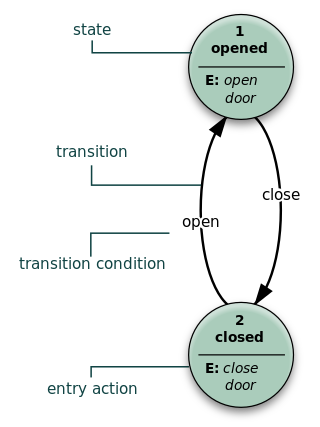
A state diagram is a type of diagram used in computer science and related fields to describe the behavior of systems. State diagrams require that the system described is composed of a finite number of states; sometimes, this is indeed the case, while at other times this is a reasonable abstraction. Many forms of state diagrams exist, which differ slightly and have different semantics.
Appreciative inquiry (AI) is a model that seeks to engage stakeholders in self-determined change. According to Gervase Bushe, professor of leadership and organization development at the Beedie School of Business and a researcher on the topic, "AI revolutionized the field of organization development and was a precursor to the rise of positive organization studies and the strengths based movement in American management." It was developed at Case Western Reserve University's department of organizational behavior, starting with a 1987 article by David Cooperrider and Suresh Srivastva. They felt that the overuse of problem solving hampered any kind of social improvement, and what was needed were new methods of inquiry that would help generate new ideas and models for how to organize.

David Cooperrider, is the Fairmount Minerals Chair and Professor of Social Entrepreneurship at the Weatherhead School of Management at Case Western Reserve University, and Faculty Director at the Center for Business as an Agent of World Benefit at Case.

Brainstorming is a group creativity technique by which efforts are made to find a conclusion for a specific problem by gathering a list of ideas spontaneously contributed by its members.

A flowchart is a type of diagram that represents a workflow or process. A flowchart can also be defined as a diagrammatic representation of an algorithm, a step-by-step approach to solving a task.
Scenario planning, scenario thinking, scenario analysis, scenario prediction and the scenario method all describe a strategic planning method that some organizations use to make flexible long-term plans. It is in large part an adaptation and generalization of classic methods used by military intelligence.

Business process modeling (BPM) in business process management and systems engineering is the activity of representing processes of an enterprise, so that the current business processes may be analyzed, improved, and automated. BPM is typically performed by business analysts, who provide expertise in the modeling discipline; by subject matter experts, who have specialized knowledge of the processes being modeled; or more commonly by a team comprising both. Alternatively, the process model can be derived directly from events' logs using process mining tools.
A data-flow diagram is a way of representing a flow of data through a process or a system. The DFD also provides information about the outputs and inputs of each entity and the process itself. A data-flow diagram has no control flow — there are no decision rules and no loops. Specific operations based on the data can be represented by a flowchart.
Business analysis is a professional discipline focused on identifying business needs and determining solutions to business problems. Solutions may include a software-systems development component, process improvements, or organizational changes, and may involve extensive analysis, strategic planning and policy development. A person dedicated to carrying out these tasks within an organization is called a business analyst or BA.
Business process mapping refers to activities involved in defining what a business entity does, who is responsible, to what standard a business process should be completed, and how the success of a business process can be determined.
Eight Disciplines Methodology (8D) is a method or model developed at Ford Motor Company used to approach and to resolve problems, typically employed by quality engineers or other professionals. Focused on product and process improvement, its purpose is to identify, correct, and eliminate recurring problems. It establishes a permanent corrective action based on statistical analysis of the problem and on the origin of the problem by determining the root causes. Although it originally comprised eight stages, or 'disciplines', it was later augmented by an initial planning stage. 8D follows the logic of the PDCA cycle. The disciplines are:
Collaborative methods are processes, behaviors, and conversations that relate to the collaboration between individuals. These methods specifically aim to increase the success of teams as they engage in collaborative problem solving. Forms, rubrics, charts and graphs are useful in these situations to objectively document personal traits with the goal of improving performance in current and future projects.

Participatory impact pathways analysis (PIPA) is a project management approach in which the participants in a project, including project staff, key stakeholders, and the ultimate beneficiaries, together co-construct their program theory.
In requirements engineering, requirements elicitation is the practice of researching and discovering the requirements of a system from users, customers, and other stakeholders. The practice is also sometimes referred to as "requirement gathering".
Too often systems fail, sometimes leading to significant loss of life, fortunes and confidence in the provider of a product or service. It was determined that a simple and useful tool was needed to help in the analysis of interactions of groups and systems to determine possible unexpected consequences. The tool didn’t need to provide every possible outcome of the interactions but needed to provide a means for analysts and product/service development stakeholders to evaluate the potential risks associated with implementing new functionality in a system. They needed a brainstorming tool to help ascertain if a concept was viable from a business perspective. The control–feedback–abort loop and the analysis diagram is one such tool that has helped organizations analyze their system workflows and workflow exceptions.
Diana Whitney is an American author, award-winning consultant and educator whose writings – 15 books and dozens of chapters and articles – have advanced the positive principles and practices of appreciative inquiry and social constructionist theory worldwide. Her work as a scholar practitioner has furthered both research and practice in the fields of appreciative leadership and positive organization development. She was awarded Vallarta Institute’s Annual 2X2 Recreate the World Award.

Kanban is a lean method to manage and improve work across human systems. This approach aims to manage work by balancing demands with available capacity, and by improving the handling of system-level bottlenecks.
Business requirements, also known as stakeholder requirements specifications (StRS), describe the characteristics of a proposed system from the viewpoint of the system's end user like a CONOPS. Products, systems, software, and processes are ways of how to deliver, satisfy, or meet business requirements. Consequently, business requirements are often discussed in the context of developing or procuring software or other systems.
Opportunity management (OM) has been defined as "a process to identify business and community development opportunities that could be implemented to sustain or improve the local economy".
Appreciative Inquiry (AI) is an approach that believes improvement is more engaging when the focus is made on the strengths rather than the weaknesses. People tend to respond to positive statements but react to negative statements that concern them. Children are more sensitive to their self-worth and thrive on what makes them feel good, what makes them feel accepted, included and recognized. AI is a powerful tool that can be used in the field of Education to enable children discover what is good about them and dream of what they can do with this realization. Children of today are very sensitive and make decisions in haste which sometimes costs them their lives. In such a situation, AI plays a very vital role.








